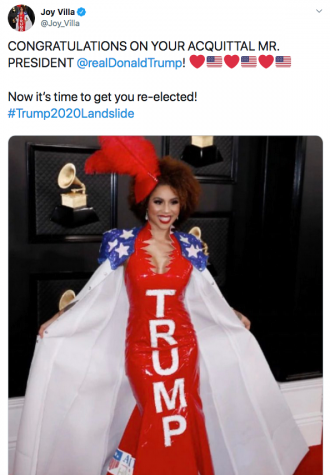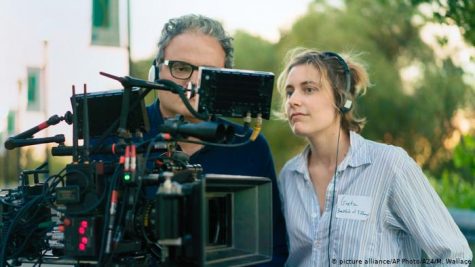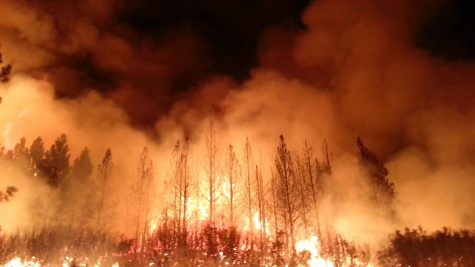‘Addressing The Climate Crisis’ — What can be done to end climate change?
Gary White from The Climate Reality Project presented “Addressing The Climate Crisis”, a lecture explicating the causes and consequences of climate change and what we can do to fight it on Thursday, April 5.
Founded by former U.S. Vice President Al Gore in 2011, The Climate Reality Project’s 16,000 volunteers educate people through worldwide training sessions about climate change. White, who’s one of the 16,000 Climate Really Project volunteers, is also a representative of the Citizens Climate Lobby, a climate organization that lobbies for legislation to support climate action.
What’s the difference between global warming and climate change?
GW: Global warming, where the entire earth is warming up then, in turn, triggers climate changes all around the world. Now, there’s not just one climate at a time, there are hundreds. It could be really, really sunny out here, it could be rainy or cold or wintery back east. Global warming creates climate extremes. So, it’s really misleading.
What can the Bay Area and California coast do to combat the drought?
GW: This is should be a favorite of Skyline, for Pacifica, and the entire coast: fog captures. … It should be coming soon to this area. These are electric netting fences that you put up, the fog comes through, the tiny droplets of fog — which is water — comes through the fence, the netting, [and the droplets] get collected and water gets in that trough. So, I don’t care how dry it is, how many years of drought, I haven’t seen the fog get limited even in the height of the drought. So, instead of bitchin’ about the fog, well, drink it.
Why go solar?
GW: We live in a sun-soaked state. In 2002, the projection was that solar would increase by 1 gigawatt per year. So, you think, maybe, in 10 years, it might be 10; no way. The reality is 77-fold. In California in particular, which has progressive laws that promote this … and the dramatic drop in price … solar has absolutely boomed. And even better than wind, there is so much potential [for] solar, we are barely scratching the surface. You can see we’re up to 50 gigawatts — not as much as wind — but we’re making a lot of inroads and you can see corporations are now building their own solar farm. Disneyland, right now, is completely renewable energy run. Now, I mention price; this is important to know. People are not gravitating towards solar because they want to be hip, they’re really, really aggressive climate advocates like myself, they’re doing it because it’s affordable and because they create a lot of clean energy for themselves and their neighborhoods. … 40 plus years ago, it was almost $80 a watt. … Solar panels … have been around since the ‘50s, but the problem is they haven’t been affordable except in the last few years. … As the years have gone on, the price has come done to last year: less than 39 cents a watt. That means it’s 99.5 percent reduced.
How does climate change affect people socioeconomically?
GW: … How this impacts lower-income communities and people of color more so than in wealthier communities, you can see race turns out to be the most significant predictor of a person living with contaminated air, water and soil. Why is that? Well, in the lower-income environments and communities which are typically at sea level, you can see coal plants, you can see oil refineries and other types of very, very dirty industries that are very, very, very close by which really pollutes that area. Also, you can see that a majority of people of color live near these toxic sites, they have a 30 percent higher rate of nitrogen dioxide exposure which is lethal and are twice as likely without … moderate sanitation.
What role does livestock raised for human consumption play in climate change?
GW: It’s been shown that the amount of greenhouse gases that are released from … animals that we raise for human consumption really add to the problem, no less the amount of grain and water that we have to use to raise these animals. So, there’s a real movement not just in the climate community but across the board for people to either adopt vegetarianism, veganism or simply eat one or two meals per week without meat. That alone would have a huge impact.
Towards the end of the event, handouts titled, “What Can I Do to Fight Climate Change?”, were passed around for attendees to see what they can do personally and politically to fight climate change. Some personal actions include “reduce, reuse, recycle” and “replace incandescent light bulbs with compact fluorescent or LED lights.” Political actions White included are “join climate activist organizations” and “invest in renewable energy companies.”













Bill Hurley • Apr 14, 2018 at 8:04 pm
I really appreciate the format of this piece. I have one difference however. When it comes to the economically disadvantaged – yes, absolutely they are more prone to be near the polluting plants and are in low areas more prone to flooding. But I’m confronted often with center-right mindsets that dismiss the US contribution to climate change when it’s compared to China or India.
I find this is based on an incorrect view of what Global Warming really is. And the impacts. Aerosols actually cool the planet (and I think soot pollution also). To confuse what the US did in the 70’s with unleaded gasoline and catalytic convertors and CAFE standards etc, with what results from additional GHGs (in my experience) causes many to think “Well, the US is clearer and we’ve already regulated PLENTY compared to China and India.”
Once that mindset sets in, all my references to melting glaciers and artic changes become suspect and this audience pays little attention.
Jan Freed • Apr 14, 2018 at 2:26 pm
Two more suggestions:
a. completely eliminate your personal carbon footprint for a few dollars/mo. See carbonfund.org well respected and ethical
b. elect serious candidates. There are powerful remedies , such as carbon fee and dividend, waiting for political will to pass